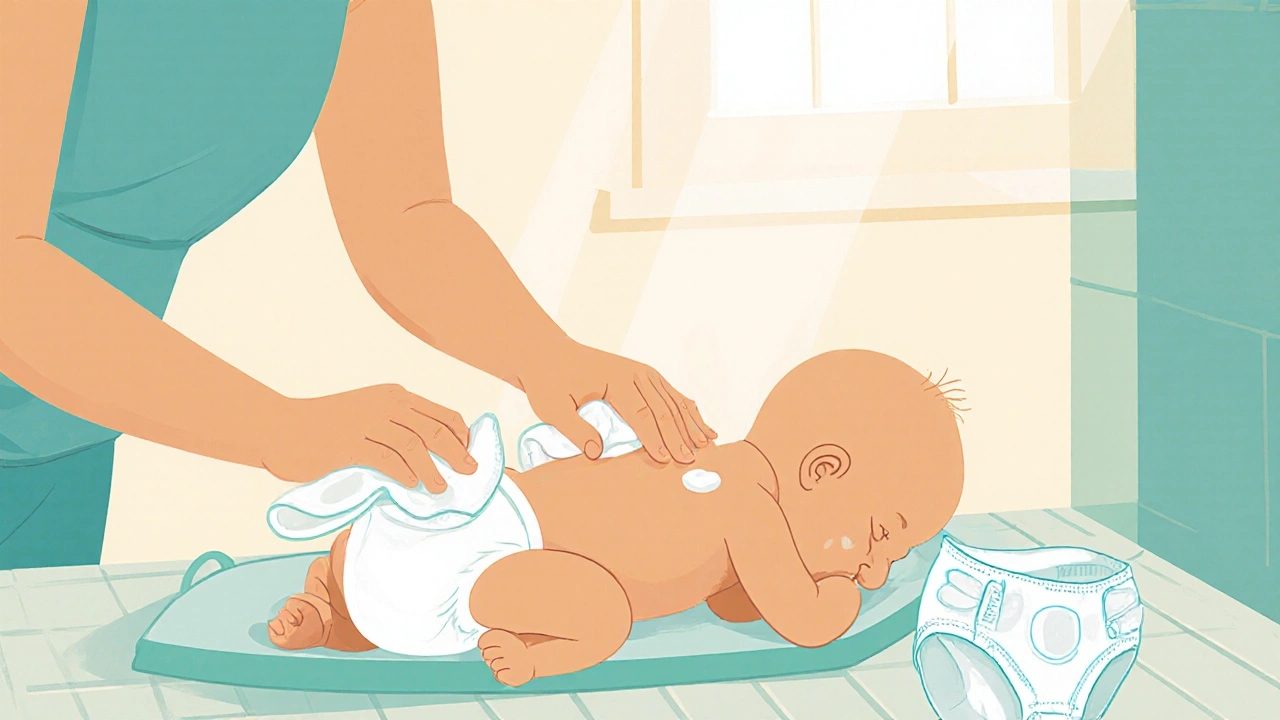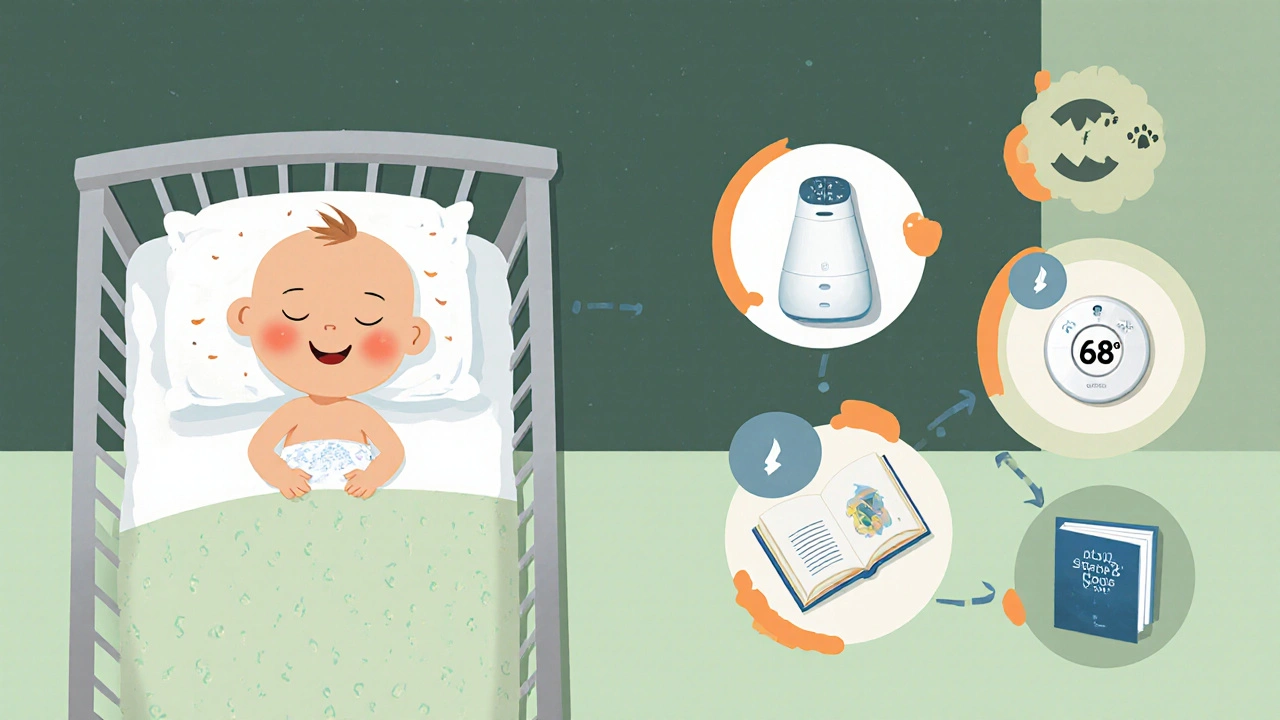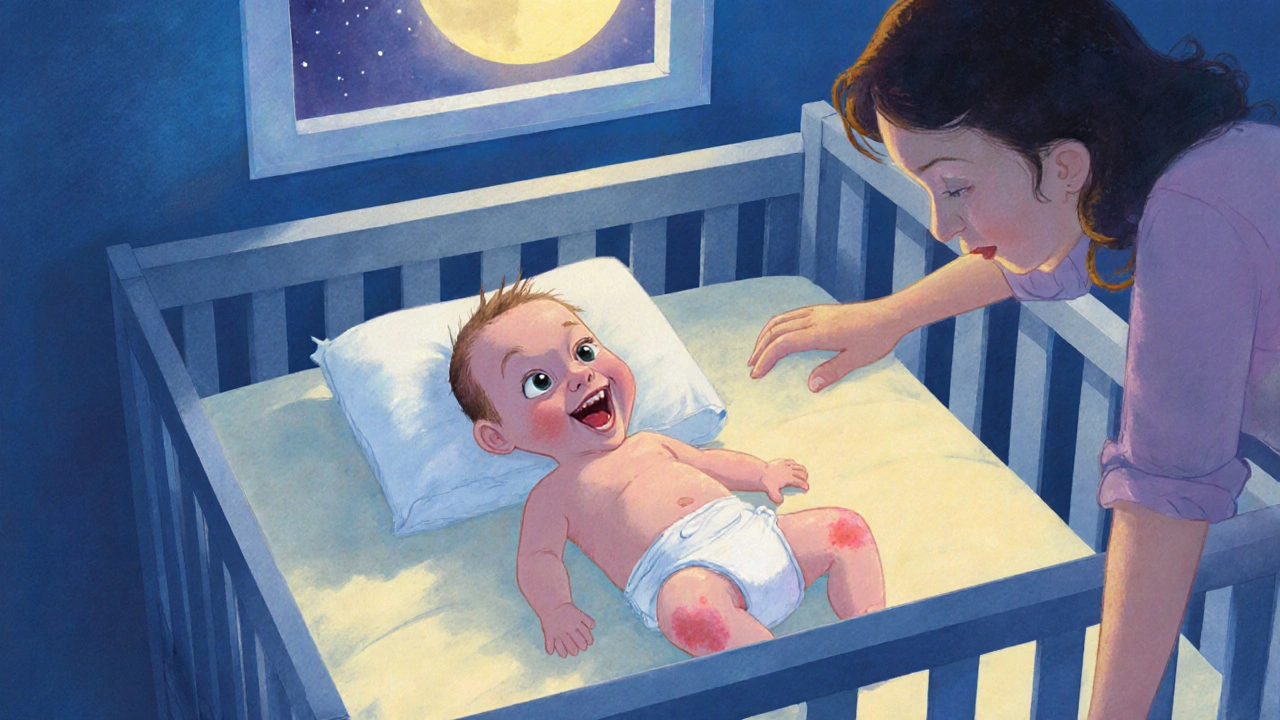Diaper Rash Healing Estimator
Enter details about your baby's rash and care routine. This tool estimates healing time based on the article's guidelines. Note: This is a general estimate; always consult your pediatrician for severe cases.
Ever wonder why your baby wakes up crying in the middle of the night, even after a full feed? The diaper rash might be the hidden culprit. In this guide we’ll unpack how skin irritation in the diaper area can throw a baby’s sleep cycle off‑track, and give you practical steps to calm both rash and restless nights.
What Is Diaper Rash?
Diaper Rash is a red, irritated patch of skin that appears in the area covered by a diaper. It’s usually caused by prolonged exposure to moisture, friction, and irritants like urine, stool, or chemicals in wipes.
Most parents first notice it as a pink or red ring around the buttocks. In severe cases the skin may blister, ooze, or crack, making the baby uncomfortable and fussy.
How Baby Sleep Works
Baby Sleep refers to the series of sleep cycles a newborn or infant goes through, ranging from light drowsiness to deep REM sleep. Newborns spend roughly 50% of the day asleep, but this sleep is broken into short bouts.
Because babies cycle quickly between light and deep stages, any discomfort can pull them out of the deeper, restorative phase and wake them up.
Why Diaper Rash Disturbs Sleep
There are three main ways the rash interferes with sleep:
- Physical discomfort. When the skin is wet or inflamed, the baby feels a burning or itching sensation that can’t be ignored.
- Disrupted sleep cycle. A baby in light Sleep Cycle is more likely to awaken at the first sign of irritation.
- Increased wake‑to‑feed pattern. Crying from rash often leads parents to feed earlier, which shortens the night stretch.
In short, an itchy diaper can turn a night of solid sleep into a series of short, fragmented naps.
Spotting Sleep Problems Linked to Rash
Not every night‑time wake‑up means a rash, but look for these clues:
- Frequent crying right after a diaper change.
- Redness or rash that seems worse after a wet diaper.
- Baby wakes up at the same hour each night, often when the diaper would be saturated.
If you notice a pattern, it’s time to address the skin issue first.

Preventing Diaper Rash Before It Starts
Prevention is easier than treatment. Here are the basics:
- Keep the area dry. Change diapers every 2‑3 hours or as soon as they’re wet. Use a soft cloth to pat the skin dry.
- Choose breathable diapers. Look for options with a breathable outer layer and a super‑absorbent core.
- Skip scented wipes. Fragrances often contain irritants that can aggravate delicate skin.
- Apply a barrier cream. A thin layer of Barrier Cream (petroleum jelly or zinc‑oxide based) creates a protective seal.
Treating an Existing Rash
If a rash has already formed, follow these steps:
- Give the skin some air. Let the baby go diaper‑free for 10‑15 minutes a few times a day.
- Clean gently with warm water. Avoid alcohol‑based wipes.
- Identify the type of infection. Yeast Infection often shows bright red patches with satellite spots, while Bacterial Infection may produce yellow crusts or pus.
- Apply the appropriate treatment. Over‑the‑counter antifungal creams work for yeast; a pediatrician‑prescribed antibiotic ointment is needed for bacterial cases.
- Re‑apply a barrier cream after each change to lock in moisture.
Most mild rashes clear up within 3‑5 days with consistent care.
Improving Sleep While Healing the Rash
While you’re treating the skin, keep sleep hygiene in mind:
- Maintain a consistent bedtime routine. A warm bath (without bubble bath), a gentle massage, and a lullaby signal that it’s time to wind down.
- Control room temperature. A cooler room (around 68‑70°F or 20‑21°C) reduces sweating, which keeps the diaper area drier.
- Use a white‑noise machine. The steady sound masks sudden cries that can startle a baby awake.
- Choose the right diaper size. A diaper that’s too tight adds friction; one that’s too loose leaks moisture.

When to Call a Doctor
Most diaper rashes are harmless, but you should seek professional help if:
- The rash spreads beyond the diaper area.
- There is fever, pus, or blisters.
- The baby is unusually lethargic or refuses to eat.
- Sleep disruption persists despite treatment for more than a week.
These signs may indicate a more serious infection that needs prescription medication.
Quick Checklist: Rash‑Free Nights
| Step | Action |
|---|---|
| 1 | Check diaper every 2‑3hours. |
| 2 | Pat skin dry, don’t rub. |
| 3 | Apply thin layer of barrier cream. |
| 4 | Use breathable, well‑fitting diapers. |
| 5 | Keep room cool and use white‑noise. |
| 6 | Monitor for signs of infection. |
| 7 | Consult pediatrician if symptoms worsen. |
Putting It All Together
Think of diaper rash and baby sleep as a cause‑and‑effect loop. Moisture and friction spark irritation, irritation wakes the baby, and frequent waking gives the skin less time to heal. By breaking the loop-keeping the skin dry, using a barrier, and establishing a soothing sleep environment-you give both the rash and the sleep pattern a chance to reset.
Give these strategies a try for a few nights. If the rash improves and your baby starts sleeping longer stretches, you’ve cracked the code. If not, it’s worth a quick chat with your pediatrician to rule out an underlying infection.
Frequently Asked Questions
Can diaper rash cause a baby to wake up crying?
Yes. The itching and burning from a rash can interrupt a baby’s light sleep stage, causing them to wake up and cry.
How often should I change my baby’s diaper to prevent rash?
Aim for every 2‑3hours, or sooner if the diaper is wet or soiled. Frequent changes reduce moisture buildup.
What’s the best type of barrier cream?
Zinc‑oxide creams (often labeled “ diaper rash ointment”) provide a strong protective seal. Petroleum‑based ointments work well for very dry skin.
Should I use wipes if my baby has a rash?
Switch to plain warm water and a soft washcloth. Fragrances and alcohol in wipes can worsen irritation.
When is a rash a sign of infection?
If you see pus, blisters, spreading redness, or if your baby develops a fever, contact a pediatrician right away.

Pranesh Kuppusamy
October 16, 2025 AT 14:57The interplay of moisture and friction creates a subtle cascade that can infiltrate a newborn's sleep architecture. When the skin barrier is compromised the nociceptive signals awaken the infant from light REM phases. This mechanism explains why a seemingly minor rash escalates into frequent nocturnal crying. Understanding this cascade is essential for any caregiver seeking restorative nights.
Crystal McLellan
October 26, 2025 AT 14:07i think the big diaper companies hide the real cause they use chemicals that mess with your baby’s skin and the govt pretends it’s just normal irritation. they don’t want you to know the truth about how it wrecks sleep because you’d demand safer products. change to cloth diapers and you’ll see the difference.
Kelly Thomas
November 5, 2025 AT 14:17Picture a tiny explorer drifting into dreamland only to be jolted awake by a sudden sting in the diaper region. That sting is the body’s alarm system warning that the delicate skin barrier has been breached. When the barrier fails, moisture and waste become irritants that trigger inflammation. Inflammation releases histamines that create that itchy, burning sensation. Even a brief flash of discomfort can yank a baby out of the deep, restorative REM stage. Because infants cycle quickly between light and deep sleep, they have little cushion to absorb the disturbance. The result is a cascade of wake‑to‑feed episodes that fragment the night. Frequent waking also means the skin has less time to air out and heal, reinforcing the rash. Breaking this vicious loop starts with a proactive diaper routine. First, swap to breathable, well‑fitting diapers that whisper rather than chafe. Second, pat the area dry with a soft cloth-no rubbing, which could exacerbate friction. Third, lay a thin veil of zinc‑oxide ointment to seal the skin from moisture. Give the baby a few diaper‑free minutes each day to let the skin breathe. Maintain a calm bedtime ritual-warm bath, gentle massage, and a soft lullaby-to signal safety. A cooler room temperature, around 68‑70°F, helps keep sweat from adding extra dampness. Finally, stay vigilant for signs of infection such as yellow crusts or fever, and call the pediatrician if they appear.
Alison Poteracke
November 15, 2025 AT 14:27That summary is clear and easy to follow; it gives new parents a step‑by‑step plan they can start using tonight.
Marianne Wilson
November 25, 2025 AT 14:37While the guide is thorough, I must point out that not every baby reacts the same way to diaper materials, so blanket recommendations can be misleading.
Patricia Bokern
December 5, 2025 AT 14:47oh my god the diaper cartel is real and they’re laughing at our sleepless nights.
Garrett Gonzales
December 15, 2025 AT 14:57From a dermatological perspective, the disruption in the stratum corneum’s lipid matrix precipitates transepidermal water loss, which in turn activates peripheral nociceptors and fragments the ultradian sleep cycle.